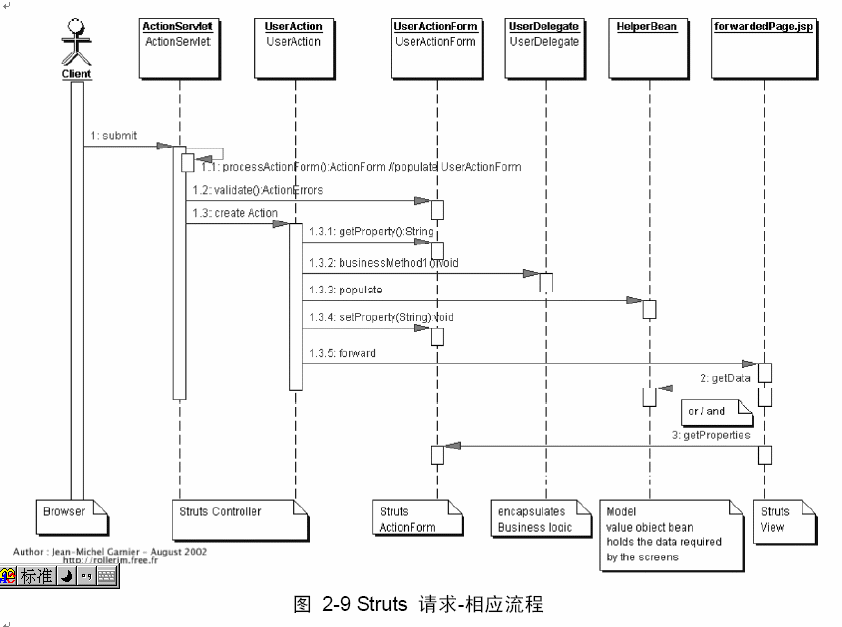snail的Struts学习笔记(1)
snail的Struts学习笔记(1) --- Simple Form Example的流程
( 06 年 10 月 20 日 )
在http://struts.apache.org/网站在下载struts- 1.3.5 -all.zip包
参考资料:
在网上找了2本书Jakarta Struts 编程.pdf,Struts in Action 中文修正版.pdf
加上官方的http://struts.apache.org/1.x/userGuide/index.html 的英文文档
看了Struts in Action的第二章节,内容上没有什么难理解的地方,但是光看没什么实际的认识。还
得操作一下,所以就把struts- 1.3.5 -all.zip解压缩,找里面的一个例子实际学习一下!(找个最简单的)
struts- 1.3.5 -all/struts-1.3.5/apps/struts-cookbook-1.3.5.war
整个的程序的所有文件:
| Source Code for Simple Form Example JavaServer Pages Simple.jsp SimpleResults.jsp Actions SuccessAction.java ProcessSimpleAction.java ActionForm SimpleActionForm.java Configuration files struts-config.xml Other source files None |
现在把整个流程走一下L(不知道有没有错)
1 用户浏览器访问Simple.jsp,填写表单,点击submit按钮。(客户端发生的事情)
这是Simple.jsp页面的一部分。
<html:form action="/processSimple">
<p>* What's your first name?:<br/><html:text property="name" size="40" maxlength="50"/></p>
<p>* Enter a secret word or phrase:<br/><html:password property="secret" size="40" maxlength="50"/></p>
。。。。。
2 当用户提交Submit按钮时,提交表单。用户的请求就发送到服务器,服务器把请求传给ActionServlet。(服务端发生的事情)
ActionServlet在自己的配置表里查找表单指定的”/processSimple”。
(” /processSimple”在struts-config.xml已配置,见下图。应用服务器一开启,ActionServlet就将struts-config里的所有配置加载进自己的某个或多个实例变量中去了。
所以上面ActionServlet能找到”/processSimple”,见下图”/processSimple”的配置)
| "/processSimple"在struts-config.xml中的配置。 <action path="/processSimple" type="examples.simple.ProcessSimpleAction" name="simpleForm"//表单的名字,不是实际javaBean类的名字 scope="request" input="/jsp/simple/Simple.jsp" cancellable="true" //表单可以被取消 validate="true"> //表单在提交到ProcessSimpleAction前需要被验证 <forward name="success" path="/jsp/simple/SimpleResults.jsp"/> </action>
Struts in Action第二章书上的一张图,下面参考这张图详细描述下接下来发生的事情。
根据图中所示: 1 当ActionServlet查找到”/processSimple”时,查找属性中有没有form bean,结果发现了 “simpleForm”. 2 然后在又在自己的配置里找到了“simpleForm”所对应的SimpleActionForm的类。 " simpleForm "在struts-config.xml中的配置。 <form-beans> <!-- Simple ActionForm Bean --> <form-bean name="simpleForm" type="examples.simple.SimpleActionForm"/> </form-beans> 3如果是服务器开始后的第一次访问这个bean,则创建SimpleActionForm的一个新的实例。否则则重设它。 4 查找”/processSimple”的validate的属性是否是”true”.如果为true的话,就调用SimpleActionForm的 validata()方法 public ActionErrors validate( ActionMapping mapping, HttpServletRequest request) {
ActionErrors errors = new ActionErrors();
// Name must be entered if ((name == null) || (name.length() < 1)) { errors.add("name", new ActionMessage("errors.name.required")); }
// Secret Phrase must be entered if ((secret == null) || (secret.length() < 1)) { errors.add("secret", new ActionMessage("errors.secret.required")); } return (errors); } 5 现在假设validata()验证正确,则ActionServlet创建Action类ProcessSimpleAction类 (ProcessSimpleAction类如果已实例化过的话,则直接调用,否则创建)。 6 ProcessSimpleAction的execute()方法被调用 public ActionForward execute( ActionMapping mapping, ActionForm form, HttpServletRequest request, HttpServletResponse response) throws Exception {
// If user pressed 'Cancel' button, // return to home page if (isCancelled(request)) { return mapping.findForward("home"); }
// Forward to result page return mapping.findForward("success"); } 7 ProcessSimpleAction返回ActionForward对象给ActionServlet,这里假设执行到 return mapping.findForward("success"); 则ActionServlet在自己本身的配置中找到名为” success”的ActionForward类。 ("/processSimple"在struts-config.xml中的配置中有 <forward name="success" path="/jsp/simple/SimpleResults.jsp"/>这个ActionForward类的配置) |
3 服务起通过ActionServlet把响应发送到了客户那里,则在客户那里显示如下。(客户端发生的事情)
虽然在浏览器地址栏显示的是http://localhost:8888/struts-cookbook-1.3.5/processSimple.do
但实际用户所在的页面是上面
"/processSimple"在struts-config.xml中的配置中的
<forward name="success" path="/jsp/simple/SimpleResults.jsp"/>
SimpleResults.jsp这个页面
这个例子虽然很简单,但大致把strute做的的主要工作体现了出来。
相对于下面这张表,上面的例子么有涉及到UserDelegate, HelperBean这两个过程,不过相信对上面的流程很熟悉的话,再找个复杂一点点的例子
把这两个过程也走一遍的话,相信对Struts的工作模式有个更好的里。
现在对Struts 的整个工作模式有了很好的理解,可以正式开始看书了,这样的话对书上的所讲的东西就不会不知所云了。明天继续学习Struts,今天
到此为止了。
反正第一天学习下来,感觉struts框架就是什么事情都问ActionServlet,ActionServlet什么事情都去找Struts-config.xml。
